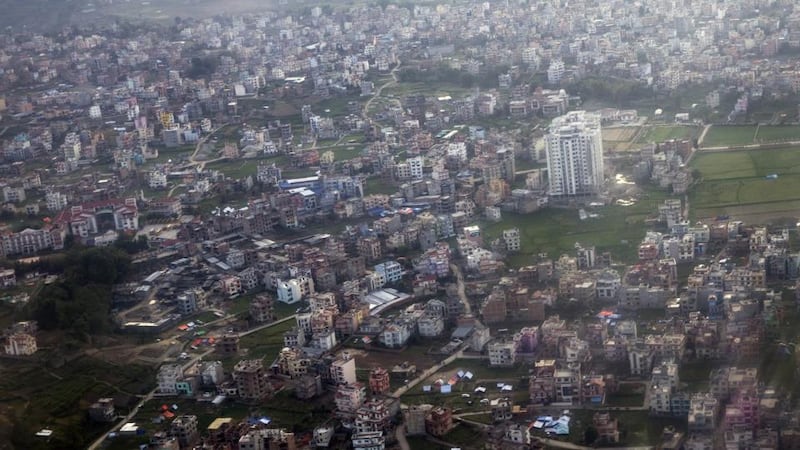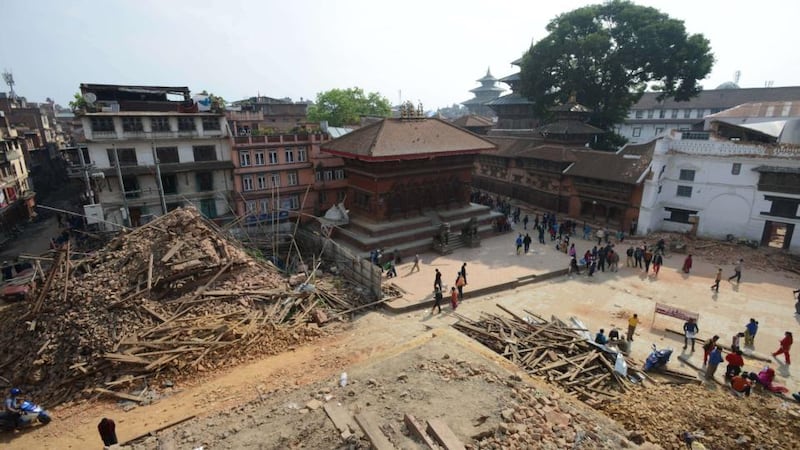Nepal has told aid agencies it does not need more foreign rescue teams to help search for survivors of Saturday's 7.9 magnitude earthquake, because its government and military could cope, the national head of the United Nations Development Programme said.
Experts have said the chance of finding people alive in the ruins was slim, more than four days after the disaster.
“After the first 72 hours, the survival rate drops dramatically and we are on day four,” said Wojtek Wilk of the Polish Centre for International Aid, an NGO which has six medical staff and 81 firefighters in Nepal. “On the fifth day it’s next to zero.”


Prime minister Sushil Koirala had earlier told reporters the death toll could reach 10,000, as information of damage from far-flung villages and towns has yet to come in.
Mr Koirala did not say on what basis he was estimating the leap in the death toll, but the government has said it is still to establish contact with some remote regions.
The figure would surpass the 8,500 who died in a 1934 earthquake, the last disaster on this scale to hit the Himalayan nation.
People stranded in remote villages and towns across Nepal were still waiting for aid and relief to arrive on Tuesday, four days after a devastating earthquake destroyed buildings and roads and killed more than 4,600 people.
The government has yet to fully assess the full scale of the damage wrought by quake, unable to reach many mountainous areas despite aid supplies and personnel pouring in from around the world.
Rescue team
In a rare glimmer of hope, a Nepali-French rescue team pulled a 28-year-old man, Rishi Khanal, from a collapsed apartment block in Kathmandu after he had spent about 80 hours trapped in a room with three dead bodies.
In Jharibar, a village in the hilly Gorkha district of Nepal close to the quake’s epicentre, a woman dug for hours in the rubble of her collapsed home to recover the bodies of two of her children, a 10-year-old daughter and eight-year-old son.
Another son aged four miraculously survived.
In Barpak, further north, rescue helicopters were unable to find a place to land. On Tuesday, soldiers had started to make their way overland, first by bus, then by foot.
Army helicopters also circled over Laprak, another village in the district best known as the home of Gurkha soldiers.
A local health official estimated that 1,600 of the 1,700 houses there had been razed. Helicopters dropped food packets in the hope that survivors could gather them up.
In Sindhupalchowk, about 3.5 hours by road northeast of Kathmandu, the earthquake was followed by landslides, killing 1,182 people and seriously injuring 376. A local official said he feared many more were trapped and more aid was needed.
“There are hundreds of houses where our people have not been able to reach yet,” said Krishna Pokharel, the district administrator. “There is a shortage of fuel, the weather is bad and there is not enough help coming in from Kathmandu.”
All the climbers who had been stranded at camps high up on Everest had been flown by helicopters to safety, mountaineers reported on Tuesday.
Up to 250 people were missing after an avalanche hit a village in Rasuwa district, a popular trekking area to the north of Kathmandu, district governor Uddhav Bhattarai said.
Officials acknowledged that they were overwhelmed by the scale of the disaster.
“The big challenge is relief,” said chief secretary Leela Mani Paudel, Nepal’s top bureaucrat. “We are really desperate for more foreign expertise to pull through this crisis.”
“The government is doing all it can for rescue and relief on a war footing,” prime minister Sushil Koirala told reporters. “It is a challenge and a very difficult hour for Nepal.”
Residents frustrated by the government’s slow response used their bare hands to dig for signs of their loved ones.
International aid
International aid had begun arriving in the Himalayan nation of 28 million people, three days after Saturday’s 7.9 magnitude quake, but disbursement is slow.
According to the home ministry, the confirmed death toll stands at 4,349, with more than 7,000 injured.
The United Nations said 8 million people were affected by the earthquake and that 1.4 million people were in need of food.
Nepal’s most deadly quake in 81 years also triggered a huge avalanche on Mount Everest that killed at least 17 climbers and guides, including four foreigners, the worst single disaster on the world’s highest peak.
A series of aftershocks, severe damage from the earthquake, creaking infrastructure and a lack of funds have slowed rescue efforts in the impoverished, mountainous country sandwiched between India and China.
‘Torturous’
In the capital Kathmandu, youths and relatives of victims were digging into the ruins of destroyed buildings and landmarks.
“Waiting for help is more torturous than doing this ourselves,” said Pradip Subba, searching for the bodies of his brother and sister-in-law in the debris of Kathmandu’s historic Dharahara tower. The 19th century minaret collapsed on Saturday as weekend sightseers clambered up its spiral stairs.
“Our hands are the only machine right now,” said the 27-year-old, part of a group of locals pulling out bricks and blocks of concrete with cloth masks over their faces. “There is just no one from the government or the army to help us.”
Elsewhere in the capital’s ancient Durbar Square, groups of young men cleared rubble from around an ancient temple, using pickaxes, shovels and their bare hands. A few policemen stood by, watching.
The head of neighbouring India's National Disaster Response Force (NDRF), one of the first foreign organisations to arrive in Nepal to help in the search and rescue effort, said finding survivors and the bodies of the dead would take time.
NDRF director-general OP Singh said heavy equipment could not fit through many of the narrow streets of Kathmandu.
“You have to remove all this rubble, so that will take a lot of time... I think it’s going to take weeks,” he told Indian television channel NDTV late on Monday.
Many people across Nepal slept in the open for a third night, their homes either flattened or threatened by tremors that spread more fear among a traumatised population.
In Kathmandu, as elsewhere, thousands are sleeping on pavements, roads and in parks, many under makeshift tents.
Hospitals are full to overflowing, while water, food and power are scarce, raising fears of waterborne diseases.
Critical
There were some signs of normality on Tuesday, however, with fruit vendors setting up stalls on major roads and public buses back in operation.
But with aid slow to reach many of the most vulnerable, some were critical of the government.
“The government has not done anything for us,” said Anil Giri, who was with about 20 volunteers, looking for two of his friends presumed buried under rubble. “We are clearing the debris ourselves with our bare hands.”
“We urge foreign countries to give us special relief materials and medical teams. We are really desperate for more foreign expertise to pull through this crisis.”
The situation is worse in remote rural areas. Highways have been blocked by landslides, and many villages and communities are without water and electricity, villagers surviving on salvaged food and with no outside help.
While aid has begun arriving in the capital, including food, medical supplies, tents and dogs trained for rescue efforts, the authorities are struggling to deliver relief further afield.
A crush at the main international airport, where relief material and rescue teams are flying in while thousands of residents are trying to leave, has slowed the flow of aid.
India and China were among the first contributors to an international effort to support Nepal’s stretched resources.
On Monday, the United States announced an additional $9 million in aid for Nepal, bringing total US disaster funding to $10 million.
US and Australian military transport planes carrying search-and-rescue personnel and supplies were headed to Nepal.
Reuters










